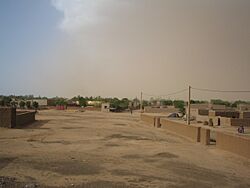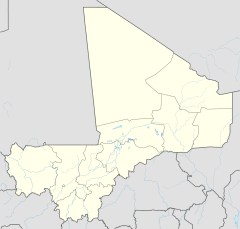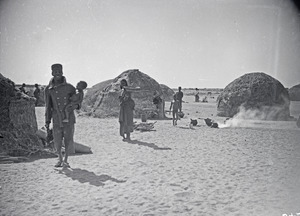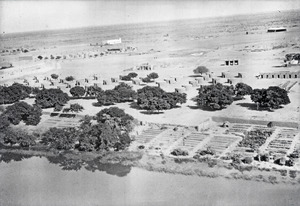Gao facts for kids
Quick facts for kids
Gao
|
|
|---|---|
|
Urban commune and town
|
|

Gao in September 2006
|
|
| Country | |
| Region | Gao |
| Cercle | Gao Cercle |
| Elevation | 226 m (744 ft) |
| Population
(2009)
|
|
| • Total | 86,633 |
| Time zone | UTC+0 (GMT) |
Gao is a city in Mali, a country in West Africa. It is the capital of the Gao Region. The city sits on the River Niger, about 320 kilometers (200 miles) east-southeast of Timbuktu. It's located on the left bank of the river, where it meets the Tilemsi valley.
For a long time, Gao was a very important trading center. It was a key stop for goods crossing the Sahara Desert. By the late 10th century, its ruler was Muslim. Later, in the late 1200s, Gao became part of the large Mali Empire.
In the early 1400s, Gao became independent again. It then became the capital of the powerful Songhai Empire under Sunni Ali (who ruled from 1464 to 1492). But the Songhai Empire fell apart after the Moroccan invasion in 1591. The invaders chose Timbuktu as their capital instead.
By 1854, when explorer Heinrich Barth visited, Gao was a small village. In 2009, about 86,633 people lived there.
In 2012, Gao was taken over by rebel groups. They declared the area independent as the nation of Azawad and named Gao its capital. However, the rebels lost control to other groups. French military forces helped recapture the city in early 2013.
Contents
Gao's Location & Surroundings
Gao is on the eastern side of the Niger River, where the Tilemsi Valley joins it. It's the biggest town in eastern Mali. A paved road connects it to Bamako, Mali's capital, which is about 1200 kilometers (750 miles) away.
In 2006, the Wabaria bridge was opened. This bridge made it easier to cross the Niger River, replacing an old ferry service. It was built with help from the Islamic Development Bank and the Malian government.
Gao also has unpaved roads leading to the desert Kidal Region in the north and to Niamey, the capital of Niger, in the south. The road south follows the river's left bank. The town of Ansongo is 103 kilometers (65 miles) from Gao. The border with Niger is about 204 kilometers (127 miles) away. Interestingly, the prime meridian (the 0-degree longitude line) passes right through Gao!
There are also boat services on the Niger River during certain times of the year. A service runs between Gao and Koulikoro, a distance of 1380 kilometers (860 miles). This usually happens from late July to mid-November, when the river has enough water after the yearly rains.
In 2009, Gao had a population of 86,633 people. The city is divided into nine main areas called quartiers.
Weather in Gao
Gao has a very hot and dry climate. It's known as an arid climate. The only rain falls between June and September, with August usually being the wettest month. On average, Gao gets only about 220 millimeters (8.7 inches) of rain each year.
May is the hottest month, with daily high temperatures averaging 43°C (109°F). December and January are the coolest months, with daily low temperatures around 15°C (59°F). From October to March, a dry, dusty wind called the Harmattan blows from the Sahara Desert.
Because there's so little rain, the plants away from the river are sparse. You'll mostly find different types of Acacia trees and Balanites aegyptiaca.
Niger River's Yearly Flood
Most farming in Gao depends on water from the Niger River. The river floods every year because of heavy rainfall in the areas where the Niger and Bani rivers begin, in Guinea and the northern Ivory Coast. The rain peaks in August, but it takes time for the floodwaters to travel down the river to Gao.
At Gao, the flood lasts longer and reaches its highest point in December. The amount of flooding can change a lot from year to year. Dams built upstream can reduce the river's flow, which might affect local farming. When the river floods, it can be 4 kilometers (2.5 miles) wide at Gao. But during the dry season, many islands appear in the river. In June and July, there's very little water flowing, only about 5% of the maximum.
Gao's Rich History
The history of the Gao Empire came before the Songhai Empire. Both empires had Gao as their capital city. We don't have many written records from Gao itself before the mid-1600s. Most of what we know about its early history comes from Arabic writers who lived in places like Morocco and Egypt. They called the town Kawkaw or Kuku.
Later, two important books from the 1600s, the Tarikh al-Sudan and the Tarikh al-fattash, tell us about Gao during the Songhai Empire. These books probably used stories passed down by word of mouth for the earlier times.
Early Gao Empire
Archaeological digs show that Gao was a busy place by about 700 CE. It was a center for making things, smelting iron, and trading with distant places like Mesopotamia. It was the southern end of a trade route that used chariots and connected to the Mediterranean Sea.
By the early 900s, the Songhay king moved to a spot called Gao Ancien, near the modern city. The earliest mention of Gao in writing is from the early 800s, when it was already a powerful regional center.
Around 872, a writer named Al-Yaqubi said: "There is the kingdom of the Kawkaw, which is the greatest of the realms of the Sūdān, the most important and most powerful. All the kingdoms obey its king."
By the 900s, Gao was already a Muslim city. It was described as having two separate towns. One town on the eastern bank of the Niger River, called Sarnāh, had markets and trading houses. The king and his trusted people lived in another town to the west of the river.
Archaeological findings suggest there were two settlements on the eastern bank: Gao Ancien (within the modern town) and Gao-Saney, about 4 kilometers (2.5 miles) east. Pottery and glass from Gao-Saney show it was active between the 700s and 1000s.
The Tarikh al-Sudan says that in 1009–1010 AD, the 15th ruler, Zuwa Kusoy, was the first to become Muslim.
Gao in the Mali Empire
In the late 1200s, Gao lost its independence and became part of the growing Mali Empire. We don't know what happened to its rulers.
The famous traveler Ibn Battuta visited Gao in 1352–53. At that time, Gao was part of the Mali Empire. He traveled there by boat from Timbuktu and described it as a great city on the Niger River, one of the finest and most fertile in the Sudan. He noted that people bought and sold things using cowrie shells, just like in Mali.
Gao in the Songhai Empire
Around the 1300s, a ruler named Ali Kulun tried to break free from Mali, but Mali regained control. It wasn't until the early 1400s that Sunni Sulayman Dama finally freed Gao from Mali's rule. His successor, Sunni Ali Ber (1464–1492), greatly expanded the Songhai territory and made Gao its capital. This was the start of the powerful Songhai Empire.
Leo Africanus visited Gao between 1506 and 1510, when Askiya Muhammad I ruled the city. He noted that Gao was a large town without a wall, full of rich merchants. He said it was very civilized compared to Timbuktu, with plenty of food like bread, meat, rice, melons, and cucumbers. He also mentioned a market where many enslaved people were sold.
By the late 1500s, the Songhai Empire controlled a huge area, about 1,400,000 square kilometers (540,000 square miles). A survey in the 1580s found over 7,600 houses in Gao, suggesting a population of about 45,000 people. This made Gao one of the largest cities in West Africa at the time.
The Moroccan invasion in 1591 caused the Songhai Empire to collapse. The invaders chose Timbuktu as their capital, and Gao's importance declined. When the German explorer Heinrich Barth visited in 1854, Gao was just a village of about 300 huts. The people were very poor.
Gao in the 21st Century
On March 31, 2012, Malian military forces left Gao. This allowed rebel groups, including the MNLA and Ancar Dine, to take control. The next day, Timbuktu was also captured. On April 6, the MNLA declared the region independent as the nation of Azawad and named Gao its capital.
However, after a battle in June 2012, the MNLA lost control of Gao to other groups. In January 2013, French warplanes bombed parts of Gao to drive out these groups. French and Malian forces recaptured Gao on January 26, 2013.
Culture in Gao
Most people in Gao speak Koyraboro Senni. But the city is home to many different ethnic groups. These include the Bozo (who traditionally live on the river), Fulfulde/Fulani cattle herders, Tuareg nomads, Arabs, and Bambara people from western Mali.
Gao also hosts the Festival des arts et cultures songhay (Festival of Songhay Arts and Cultures). This festival shows how important Gao is as a center for Songhay culture.
Places to See in Gao
Gao has several interesting places to visit:
- The original 14th-century Kankou Moussa Mosque.
- The Askia Tomb, a World Heritage Site built in 1495. It includes another mosque.
- A museum about the Sahel region.
- Local markets, including a night market.
- La Dune Rose, a large sand dune that looks pink at dawn and nightfall.
Gao's Mosques
The mosques in the Niger Bend area, like those in Gao, have a unique style. Their main front walls are smooth, without many vertical decorations. Inside, the pillars are very thick, and there are no arches. Only the minaret (the tower from which calls to prayer are made) stands tall.
Mosques of the Past
Gao has a rich history with three main settlements: Gao Saney, Old Gao, and modern Gao. Digs at Gao Saney, the oldest site, found a royal cemetery with old tombstones. Old Gao was built between the 700s and 900s and existed at the same time as Gao Saney.
At Old Gao, archaeologists found two large buildings from the early 900s. One of these is believed to be a mosque. It was an important building for the community, likely used for worship and gatherings. This mosque is one of the oldest found in West Africa, showing how early Islam spread in the region.
The mosque and tomb of Askia Muhammad was built between 1493 and 1538. This huge building covers about 2500 square meters (27,000 square feet). Its courtyard was larger than the prayer hall, and a 12-meter (39-foot) minaret stood in the center. This minaret was similar to the famous Ibn Tulun's mosque in Cairo, showing architectural influences from far away.
Education
Gao has schools, including primary schools for children.
Famous People from Gao
- Askia Muhammad I – a very important ruler of the Songhai Empire.
Gao's Sister Cities
Gao is twinned with these cities:
 Thionville, France
Thionville, France Berkeley, California, United States
Berkeley, California, United States
See Also
- List of cities in Mali
- Koïma





